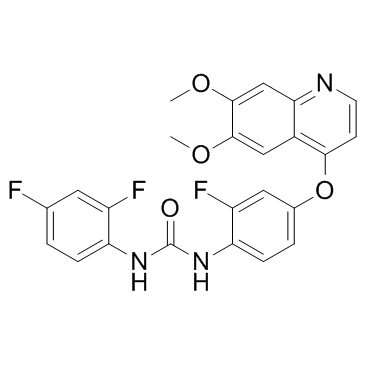228559-41-9
| Name | 1-(2,4-difluorophenyl)-3-[4-(6,7-dimethoxyquinolin-4-yl)oxy-2-fluorophenyl]urea |
|---|---|
| Synonyms |
S1363_Selleck
1-(2,4-Difluorophenyl)-3-{4-[(6,7-dimethoxy-4-quinolinyl)oxy]-2-fluorophenyl}urea N-(2,4-difluorophenyl)-N'-(4-((6,7-dimethoxy-4-quinolyl)oxy)-2-fluorophenyl)urea 1-(2,4-Difluorophenyl)-3-{4-[(6,7-dimethoxyquinolin-4-yl)oxy]-2-fluorophenyl}urea Ki8751 cc-604 Ki-8751,Ki8751 |
| Description | Ki8751 is a potent VEGFR2 inhibitor with an IC50 of 0.9 nM. |
|---|---|
| Related Catalog | |
| Target |
VEGFR2:0.9 nM (IC50) |
| In Vitro | Ki8751 inhibits VEGFR-2 phosphorylation at an IC50 value of 0.90 nM, and also inhibits the PDGFR family members such as PDGFRR and c-Kit at 67 nM and 40 nM, respectively. However, Ki8751 does not have any inhibitory activity against other kinases such as EGFR, HGFR, InsulinR and others even at 10000 nM. Ki8751 suppresses the growth of the VEGF-stimulated human umbilical vein endothelial cell (HUVEC) on a nanomolar level[1]. |
| In Vivo | Ki8751 shows significant antitumor activity against five human tumor xenografts such as GL07 (glioma), St-4 (stomach carcinoma), LC6 (lung carcinoma), DLD-1 (colon carcinoma) and A375 (melanoma) in nude mice and also shows complete tumor growth inhibition with the LC-6 xenograft in nude rats following oral administration once a day for 14 days at 5 mg/kg without any body weight loss[1]. |
| Kinase Assay | VEGFR-2 kinase assay is described below; GST-fusion proteins of KDR (Flk-1: cytoplasmic domain) are produced in the baculo-virus expression system. GST-KDR is premixed with a serial dilution of Ki8751 in the kinase buffer. The kinase reaction is initiated by the addition of 2 µM ATP in a solution of MnCl2. After 20 min incubation at room temperature, the reaction is stopped with an addition of EDTA. Phosphorylation levels of GST-KDR are detected by immunoblotting with anti-phosphotyrosine monoclonal antibodies (PY20) and detected by ECL fluorography[1]. |
| Cell Assay | HUVECs are placed at a density of 4000 cells/200 µL/well on collagene type I precoated 96-well plates in M199 medium with 5% fetal bovine serum (FBS). After 24 h, the cells are incubated for 1 h in the presence or absence of Ki8751; then the cells are stimulated by rhVEGF (20 ng/mL). The cultures are incubated at 37 °C for 72 h, then pulsed with 1 µCi/well [3H]thymidine and reincubated for 14 h. Cells are assayed for the incorporation of tritium using a beta counter[1]. |
| Animal Admin | Mice: The effects of Ki8751 on tumor growth is tested against various tumors, human stomach carcinoma (St-4), human lung carcinoma (LC-6), human colon carcinoma (DLD-1) and human melanoma (A375), using human tumor xenografts in nude mice. Ki8751 is administered orally to mice in the experimental groups once a day for 9 consecutive days at 5 mg/kg, and the vehicle is administered to control animals. Tumor volumes are monitored twice weekly[1]. |
| References |
| Density | 1.4±0.1 g/cm3 |
|---|---|
| Boiling Point | 497.1±45.0 °C at 760 mmHg |
| Melting Point | 239℃ |
| Molecular Formula | C24H18F3N3O4 |
| Molecular Weight | 469.413 |
| Flash Point | 254.4±28.7 °C |
| Exact Mass | 469.124939 |
| PSA | 81.71000 |
| LogP | 5.91 |
| Vapour Pressure | 0.0±1.3 mmHg at 25°C |
| Index of Refraction | 1.657 |
| Storage condition | −20°C |
